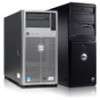Dell PowerEdge T605 Hardware Owner's Manual (PDF) - Page 218
Transmission Control Protocol/Internet Protocol., spanning, striping, system board
 |
View all Dell PowerEdge T605 manuals
Add to My Manuals
Save this manual to your list of manuals |
Page 218 highlights
SNMP - Simple Network Management Protocol. A standard interface that allows a network manager to remotely monitor and manage workstations. spanning - Spanning, or concatenating, disk volumes combines unallocated space from multiple disks into one logical volume, allowing more efficient use of all the space and all drive letters on a multiple-disk system. striping - Disk striping writes data across three or more disks in an array, but only uses a portion of the space on each disk. The amount of space used by a "stripe" is the same on each disk used. A virtual disk may use several stripes on the same set of disks in an array. See also guarding, mirroring, and RAID. SVGA - Super video graphics array. VGA and SVGA are video standards for video adapters with greater resolution and color display capabilities than previous standards. system board - As the main circuit board, the system board usually contains most of your system's integral components, such as the processor, RAM, controllers for peripherals, and various ROM chips. system configuration information - Data stored in memory that tells a system what hardware is installed and how the system should be configured for operation. system diskette - See bootable diskette. system memory - See RAM. System Setup program - A BIOS-based program that allows you to configure your system's hardware and customize the system's operation by setting features such as password protection. Because the System Setup program is stored in NVRAM, any settings remain in effect until you change them again. system.ini file - A start-up file for the Windows operating system. When you start Windows, it consults the system.ini file to determine a variety of options for the Windows operating environment. Among other things, the system.ini file records which video, mouse, and keyboard drivers are installed for Windows. TCP/IP - Transmission Control Protocol/Internet Protocol. 218 Glossary















